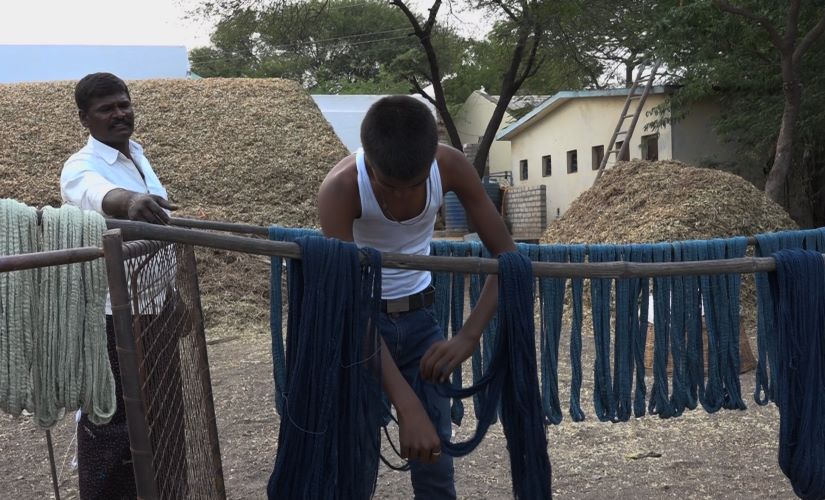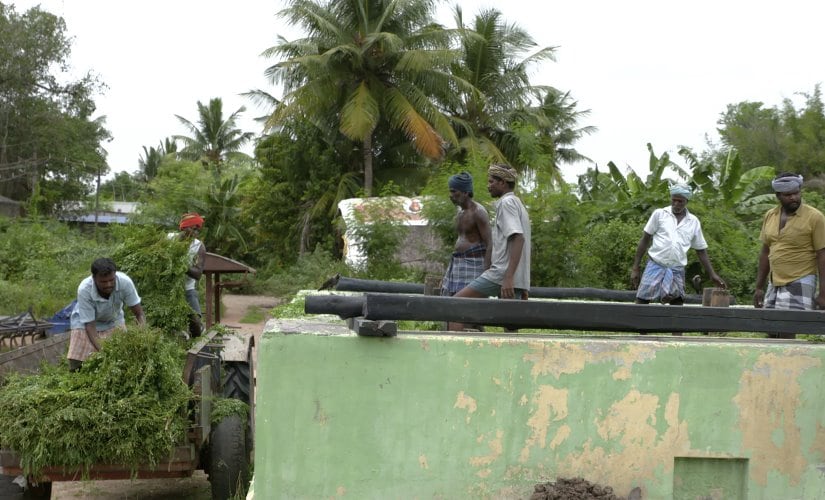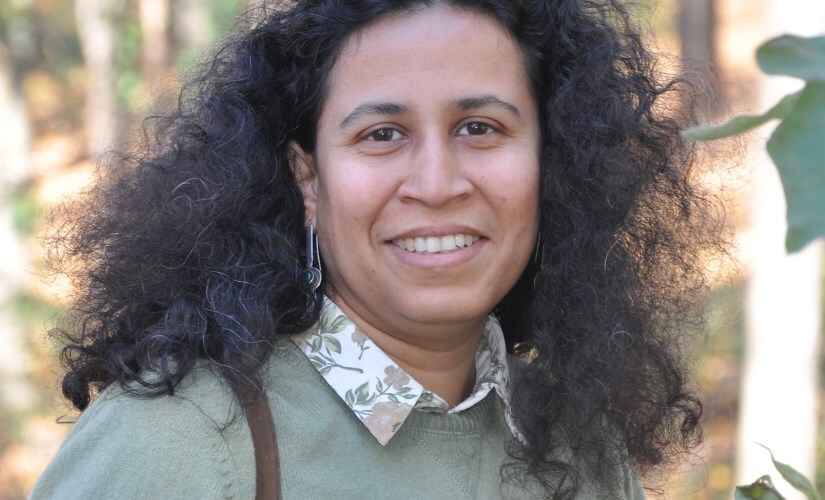It’s the hands you can’t stop thinking about. The blue hands of the indigo dyers. It is a lasting testimony to their art, to the “labour of love” as documentary filmmaker Swati Dandekar calls it. The late Yellappa, a master indigo dyer, never used the large rubber gloves, and few use it now; they need to touch, smell and even taste the dye. In 1999, Uzramma, then working with Dastkar Andhra, and now founder trustee of Malkha, which aims at an alternative model for industrial cotton, heard of Yellappa through two sources: Padmini Balaram who had done extensive documentation on indigo dyeing and Guruppa Chetti, the kalamkari artist. “We were told he is not meeting anyone from “outside” as he didn’t think anyone was interested in learning indigo dyeing. So we sent another person, the handloom activist Prasanna, on our behalf to persuade him to set up an indigo vat in Hegadu in Karnataka. Later, Prasanna got him to come and teach our weavers in Chinnur (now in Mancherial district in Telangana),” she recalls. It was a stroke of luck and everyone was so superstitious about getting Yellappa to come there that they didn’t even photograph the only man in Andhra Pradesh who practised this dying art. Yellappa’s experience at the National Institute of Design (NID) where Ms Balaram had persuaded him to take up teaching indigo dyeing, was not a happy memory for him. He felt no one was keen on learning his skill and that idea was deep-rooted in his head. Even in Chinnur, Uzramma recalls that he cribbed about everything – the heat, the water, the food, and the charpoy which was too short for him as he was a tall man. He wanted deep earthenware pots to use as vats for the dye and the young potters in the village made shallow ones, till one person agreed and did the painstaking job. The weavers of Chinnur, with their enthusiasm, dispelled some of his disillusionment and he had keen learners in Odelu and others whom Dastkar Andhra had managed to get together to revive natural dyes and crafts. [caption id=“attachment_6486001” align=“alignnone” width=“825”]
 Drying the yarn at Uravakonda. All images courtesy: Swati Dandekar[/caption] Many years later in 2011, Dandekar will be forever grateful she had taken a flip video camera with her when she went to meet Yellappa in his native Uravakonda (Anantapur district) in Andhra Pradesh, as part of her initial research for a film she was planning to make on indigo. By the time she secured funding for her film, Yellappa had passed away in 2014. It is the footage she shot with that camera that she later used in her film Neeli Raag which was recently screened at the week-long Meanings and Metaphors exhibition in Bengaluru organised by Ahalya Matthan of the Registry of Saris and curated by Mayank Kaul. Dandekar, in an interview to Firstpost, said she read about Yellappa at Uzramma’s place in Hyderabad many years ago and was intrigued by the man and the process of indigo dyeing. At that time she was completing a film on water and started seriously thinking about making a film on indigo. By then she had also read about the Chinnur experiment and how Uzramma and the Dastkar Andhra group were working with weavers and dyers to use natural dyes. “When I met Yellappa I had no clear idea what the film would be about, only that certainly he would play a part in it,” said Dandekar. Yellappa’s invaluable training to Odelu and other weavers in Chinnur also came at a time when the local weavers were fed up with working in a shed from nine to five. They were used to working from their homes, and their women did a lot of the preparatory work. It was Uzramma who propelled them to use natural dyes and she and activist Jagada Rajappa and other worked on the Chinnur group to revive the doria it was once famous for and of course the indigo and other natural dyes. “You inhabit the universe you research and uncover more stories. Anbazhagan, a farmer from Tamil Nadu and the only large scale grower and maker of indigo dye, is now aided by his internet savvy and management trained son. The son read Uzramma’s paper online ‘Weaving a Vision, the Doria of Chinnur’ and responded to it with information about their indigo processing. This is how Dandekar came to know about them and went to their village to film. The opening shots of the documentary are from this village in Tamil Nadu — bundles of small green leaves are tossed into large cement tanks filled with water by men who have been doing this traditionally. The next morning the tank is a bright bubbly blue. “The process is mesmerising — the green gives birth to blue. I wanted to show the texture and the colour and the transformation cinematically in my film,” she said. [caption id=“attachment_6486021” align=“alignnone” width=“825”]
 At the fermentation tank[/caption] The indigo-infused water is then transferred to an aeration tank. Indigo is a colour that emerges only when it comes into contact with oxygen. This liquid dye is boiled down and dried and cut into small pieces much like soap-cakes. By 2011 her proposal was ready but it was only in 2016 that she managed to get funding from Films Division, and the film was completed in 2018. It has been screened at two festivals: MAMI in Mumbai, Signs in Kerala apart from private events. She made the most use of the footage from her 2011 visit. Yellappa was 80 then, and is today survived by his wife and son Mallikarjun to whom he had rather reluctantly passed on his traditional art. Dastkar Andhra convinced his son not to let the indigo vats go bad and today both he and his wife Thippamma work and supply dyed yarn to Dastkar Andhra. This is a dry region and it supplements their meagre earnings from agriculture. However, in Uravakonda village, he is the only one practising indigo dyeing. There used to be a vibrantly active weavers’ lane here. In the older days, many of them had indigo vats in their yards, and Yellappa used to go from house to house to manage their vats. Now there is little pride in that tradition; few continue to work on handlooms. In the film, Mallikarjun scrapes off the blue from his hands with pieces of a mud tile, but the colour remains always. They get the thread and yarn for dyeing and sell it back to Dastkar Andhra which distributes it to weavers. Dandekar, who heads the film department at Srishti Institute of Art, Design and Technology, Bengaluru, has been inspired by Anand Patwardhan’s Bombay, Our City, and other films like Voices from Baliapal by Ranjan Palit and Vasudha Joshi. “Later, I came across the work of David McDougall, ethnographic filmmaker, and I respect his work, his approach, the gentleness he brings even into a grim story. Other questions that I think about are how to make images that are engaging, impactful yet responsible, and as “true” or “real” as I understand truth or reality,” she said. In her search for something meaningful, she has worked on the TV serial Surabhi, films like Blessed by the Plague (by Sunil Shanbag and Arunabha Bhattarcharjee) before starting out independently. She has collaborated with an economist on a series of films on governance and democracy. In these films, the challenge was to visualise something as invisible as governance, or how a city functions and democratic processes that operate. [caption id=“attachment_6486041” align=“alignnone” width=“825”]
 Filmmaker Swati Dandekar[/caption] She has been excited by textiles — not only because they are beautiful but because of the complex questions surrounding the erosion or continuance of traditional knowledge. “Living in a city, we have romantic perceptions about culture — but as we speak, someone is giving up an art because they have aspirations of a job in the city. Can we have a nuanced way of looking at our heritage that is neither romantic nor dismissive? People are getting de-skilled and their craft is dying. Often the little schooling they have is not enough to earn a livelihood,” she points out. “One thing I realised while making the film is that Odelu (the weaver from Chinnur), Yellappa and the farmer Anbazhagan are not a few among the many involved with indigo — they were the only ones. There are small pockets where natural dyes are happening but a whole lot of people who call their dyes indigo are not using natural dyes,” she said. Of the 12,000 kg (12-15 tonnes) of indigo dye-cakes made in India, less than 20 percent is used locally, and of this, a large chunk goes to Auroville. Most of it is exported. There are two processes involved in the making of the indigo dye. The first is, of course, to extract the colour from the plant and the next is to make it into cakes and then the actual dyeing. Dyers like Odelu take a handful of these blue-black cakes, crush them in a grinding stone and drop it into the earthen vats along with boiled cassia tora seeds and slaked lime. There is a particular mud in Anantapur district called “savudu” through which water is filtered, and used for the dye. Yellappa’s wife Lakshmamma believed using a bit of the dye from the old vats helped when you start a new one. Padmini Balaram, who as a NID student had extensively documented indigo dyeing in 1979, had photographs which Dandekar copied and took with her when she visited Lakshmamma again to revive old memories. But Lakshmamma stoutly denied it was her in the photos, a rather amusing reaction, while her family teased her.
Swati Dandekar’s film is a reminder of this 4,500-year-old tradition of indigo dyeing in India and the laborious process embedded in the life of its artisans.
Advertisement
End of Article


)
)
)
)
)
)
)
)
)



